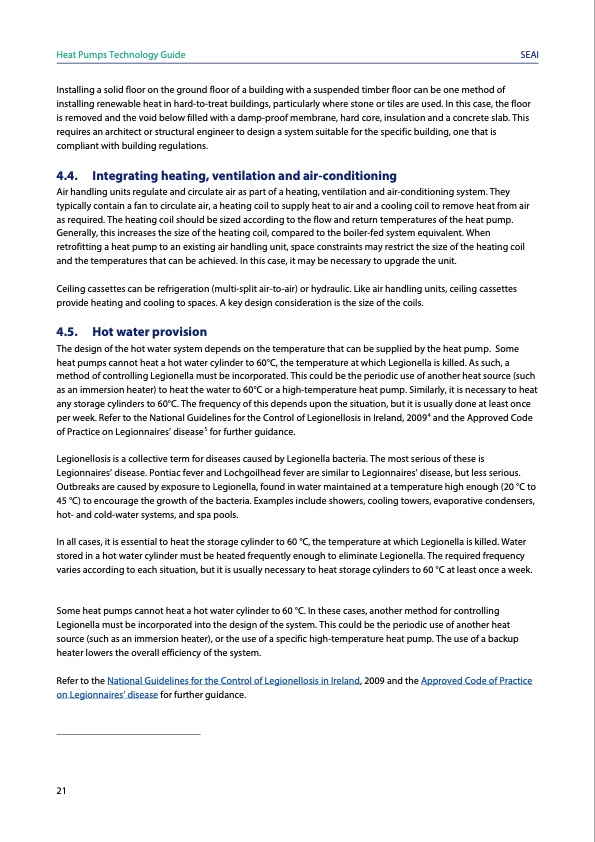
PDF Publication Title:
Text from PDF Page: 025
Heat Pumps Technology Guide SEAI Installing a solid floor on the ground floor of a building with a suspended timber floor can be one method of installing renewable heat in hard-to-treat buildings, particularly where stone or tiles are used. In this case, the floor is removed and the void below filled with a damp-proof membrane, hard core, insulation and a concrete slab. This requires an architect or structural engineer to design a system suitable for the specific building, one that is compliant with building regulations. 4.4. Integrating heating, ventilation and air-conditioning Air handling units regulate and circulate air as part of a heating, ventilation and air-conditioning system. They typically contain a fan to circulate air, a heating coil to supply heat to air and a cooling coil to remove heat from air as required. The heating coil should be sized according to the flow and return temperatures of the heat pump. Generally, this increases the size of the heating coil, compared to the boiler-fed system equivalent. When retrofitting a heat pump to an existing air handling unit, space constraints may restrict the size of the heating coil and the temperatures that can be achieved. In this case, it may be necessary to upgrade the unit. Ceiling cassettes can be refrigeration (multi-split air-to-air) or hydraulic. Like air handling units, ceiling cassettes provide heating and cooling to spaces. A key design consideration is the size of the coils. 4.5. Hot water provision The design of the hot water system depends on the temperature that can be supplied by the heat pump. Some heat pumps cannot heat a hot water cylinder to 60°C, the temperature at which Legionella is killed. As such, a method of controlling Legionella must be incorporated. This could be the periodic use of another heat source (such as an immersion heater) to heat the water to 60°C or a high-temperature heat pump. Similarly, it is necessary to heat any storage cylinders to 60°C. The frequency of this depends upon the situation, but it is usually done at least once per week. Refer to the National Guidelines for the Control of Legionellosis in Ireland, 20094 and the Approved Code of Practice on Legionnaires’ disease5 for further guidance. Legionellosis is a collective term for diseases caused by Legionella bacteria. The most serious of these is Legionnaires’ disease. Pontiac fever and Lochgoilhead fever are similar to Legionnaires’ disease, but less serious. Outbreaks are caused by exposure to Legionella, found in water maintained at a temperature high enough (20 °C to 45 °C) to encourage the growth of the bacteria. Examples include showers, cooling towers, evaporative condensers, hot- and cold-water systems, and spa pools. In all cases, it is essential to heat the storage cylinder to 60 °C, the temperature at which Legionella is killed. Water stored in a hot water cylinder must be heated frequently enough to eliminate Legionella. The required frequency varies according to each situation, but it is usually necessary to heat storage cylinders to 60 °C at least once a week. Some heat pumps cannot heat a hot water cylinder to 60 °C. In these cases, another method for controlling Legionella must be incorporated into the design of the system. This could be the periodic use of another heat source (such as an immersion heater), or the use of a specific high-temperature heat pump. The use of a backup heater lowers the overall efficiency of the system. Refer to the National Guidelines for the Control of Legionellosis in Ireland, 2009 and the Approved Code of Practice on Legionnaires’ disease for further guidance. 21PDF Image | Heat Pumps Technology Guide

PDF Search Title:
Heat Pumps Technology GuideOriginal File Name Searched:
Heat-Pump-Technology-Guide.pdfDIY PDF Search: Google It | Yahoo | Bing
CO2 Organic Rankine Cycle Experimenter Platform The supercritical CO2 phase change system is both a heat pump and organic rankine cycle which can be used for those purposes and as a supercritical extractor for advanced subcritical and supercritical extraction technology. Uses include producing nanoparticles, precious metal CO2 extraction, lithium battery recycling, and other applications... More Info
Heat Pumps CO2 ORC Heat Pump System Platform More Info
| CONTACT TEL: 608-238-6001 Email: greg@infinityturbine.com | RSS | AMP |